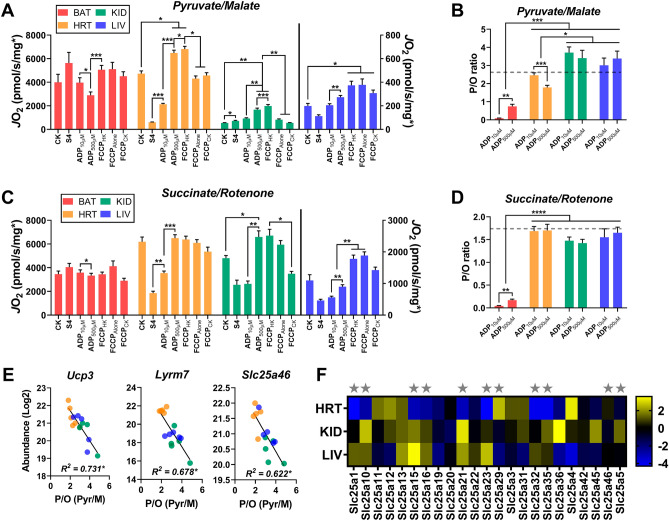Figure 5.
The mitochondrial SLC family of proteins correlate with Pyr/M supported intrinsic phosphorylation efficiency. (A) Respiration in isolated mitochondria energized with Pyr/M. Respiration was stimulated with ΔGATP of − 54.16 kJ/mol (CK), leak respiration in the absence of adenylates (S4), 0.01 mM ADP (ADP10µM), 0.5 mM ADP (ADP500µM), and FCCP in the presence of 0.5 mM ADP (FCCPHK), no adenylates (FCCPAlone), or ΔGATP (FCCPCK). (B) Relationship between mitochondrial ATP synthesis and oxygen consumption, a direct measurement of intrinsic phosphorylation efficiency (i.e., P/O ratio). Substrate condition = Pyr/M. Dashed line depicts the theoretical maximum for P/O based on the known mammalian stoichiometry of ATP synthesis. (C) Respiration in isolated mitochondria energized with succinate/rotenone. Respiration was stimulated with ΔGATP of − 54.16 kJ/mol (CK), leak respiration in the absence of adenylates (S4), 0.01 mM ADP (ADP10µM), 0.5 mM ADP (ADP500µM), and FCCP in the presence of 0.5 mM ADP (FCCPHK), no adenylates (FCCPAlone), or ΔGATP (FCCPCK). (D) Relationship between mitochondrial ATP synthesis and oxygen consumption, a direct measurement of intrinsic phosphorylation efficiency (i.e., P/O ratio). Substrate condition = succinate/rotenone. Dashed line depicts the theoretical maximum for P/O based on the known mammalian stoichiometry of ATP synthesis. (E) Correlation of MitoCarta 2.0 normalized protein abundance of Ucp3, Lyrm7, and Scl25a46 with Pyr/M supported P/O. (F) MitoCarta 2.0 normalized protein expression of identified/quantified mitochondrial SLC proteins. Stars indicate SLC proteins found to correlate with Pyr/M mediated P/O. Figures generated using GraphPad Prism 8 software (Version 8.4.2). Data information: Data are Mean ± SEM, N = 5/group. *P < 0.05, **P < 0.01, ***P < 0.001, ****P < 0.0001.

